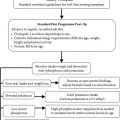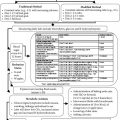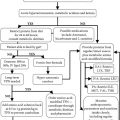13.1 Enteral Nutrition
| Indications | Associated Conditions |
| Oral motor dysfunction or dysphagia |
|
| Increased metabolic needs |
|
| Anorexia: Inadequate oral intake |
|
| Psychosocial disorders |
|
| Malabsorption: Altered metabolism and/or other increased caloric loss |
|
| Increased length of time feeding (>4–6 hours per day) |
|
13.1.1 When to Intervene with Enteral Nutrition
- Nutrient intake (energy, protein, fluid) are <75% estimated needs with concurrent weight loss.
- Child has failed trials of nutrient-dense oral supplements.
- Decrease in weight velocity (malnutrition) crosses two weight channels.
- Decrease in height velocity (stunting).
- Diminished muscle and/or fat reserves results in upper arm anthropometry <5th percentile.
- Dysphasia in NPO status.
- Therapies when expected outcome is anorexia, poor oral intake, and malnutrition without nutrition support (e.g., intensive cycles of chemotherapy).
- Weight reaches ≤90% ideal weight despite aggressive oral intervention.
13.1.2 Seattle Children’s Enteral Formulary
There are market equivalents to most formulas; below are listed examples of what is required to have a complete formulary. Closed system is ideal in the hospital setting; pediatric products available in both open and closed systems are starred (*).
Premature
- Premature formula: Enfamil Premature.
- Breast milk + Similac HMF (human milk fortifier).
- Postpremature: NeoSure.
Infants
- Breast milk (can concentrate nutrient density with infant formulas and/or modular products).
- Standard infant formulas with iron: Similac.
- Soy infant formula: Isomil.
- Hydrolyzed protein: Alimentum, Nutramigen.
- Elemental formula: EleCare Infant.
Children 1–10 Years
- Standard pediatric formulas: Nutren Jr*, Nutren Jr with Fiber*, Compleat Pediatric, Bright Beginnings (soy).
- Semi-elemental/elemental formulas: Peptamen Jr*, Peptamen Jr with Fiber*, Peptamen Jr 1.5*, Vivonex Pediatric, Elecare Jr.
Children >10 Years
- Standard adult formulas: Osmolite*, Isosource HN* (soy).
- Fiber formulas: Compleat*, FiberSource HN* (soy).
- Semi-elemental/elemental: Peptamen*, Vivonex T.E.N.
- High calorie: Nutren 2 *.
Modular Products
- Protein: Beneprotein.
- Carbohydrate: Polycose.
- Fat: Microlipid.
- Carbohydrate + fat: Duocal.
- Fiber: Nutrisource Fiber.
Specialty Products
- Renal failure, ketogenic, metabolic, critical care: Consult a dietitian.
| Length of Therapy | Route Tube | Type/Size |
| Short term | Nasogastric |
|
Nasoduodenal
|
| |
Nasojejunal
|
| |
| Long term(>3 months) | Gastrostomy: Surgical Placement
|
|
Gastrostomy: Endoscopic Placement (PEG)
|
| |
| Long term (>3 months) |







